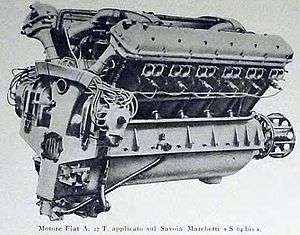Fiat A.22
| A.22 | |
|---|---|
 | |
| Fiat A.22 T | |
| Type | Water-cooled V-12 |
| National origin | Italy |
| Manufacturer | Fiat Aviazione |
| First run | 1926 |
| Number built | "several hundred"[1] |
| Developed into | Fiat AS.2 |
The Fiat A.22 was an Italian water-cooled aircraft engine from the 1920s. It produced 425 kW (570 hp) and powered several absolute world distance records as well as commercial passenger flights.
Design and development
During the second half of the 1920s Fiat introduced several water-cooled aircraft engines, including the A.20, A.22, A24, A.25 and A.30. They were all upright V-12s with 60° between the cylinder banks; capacities ranged between 18.7 L and 54.5 L (1,141-3,326 cu in) and power outputs between 320 kW and 745 kW (430-1,000 hp).[1]
Producing 425 kW (570 hp) from 27.5 L (1,678 cu in),[2] the A.22 was towards the middle of these ranges. When Fiat were advised by the government to simplify their water-cooled product line, they focussed on the A.20, A.22 and A.30 models.[3] The A.22 was first run in 1926 and a "few hundred" were built.[1]
The A.22 was developed into the Fiat AS.2 and AS.3 Schneider Trophy race engines.[3]
Operational history
The A.22 was best known for its contribution to some world long distance record flights[2] made by the single engine landplane Savoia-Marchetti S.64, which used the specially adapted A.22 T. version. Between 31 May and 2 June 1928 this aircraft flew non-stop for 7,665 km (4,763 mi) to capture the world closed circuit distance record. The flight lasted 58 hr 34 min; the two crew, Capt. Arturo Ferrarin and Major Del Prete took turns as pilot.[4] A month later, the same crew set a new world straight-line distance record of 7,187 km (4,467 mi), flying from Italy to Brazil in 47 hr 55 min. The closed circuit record was later taken by the French but a slightly revised S.64bis recovered it for Italy with a distance of 8,187 km (5,088 mi) flown in 67 hr 13 min on 31 May-2 June 1930.[4]
The A.22R powered more conventional, airline, flights in a Savoia-Marchetti S.66 three engine flying boat operated by Ala Littoria on the Rome-Cagliari-Tripoli and Rome-Athens-Alexandria routes.[4]
Variants

From Jane's all the World's Aircraft 1938[3]
- A.22
- un-geared, compression ratio 5.5:1.[5]
- A.22 R.
- (R - Riduttori - reduction gear) Geared 0.5:1, compression ratio 5.5:1.[5]
- A.22 S.
- High compression, compression ratio 6:1.[5]
- A.22 AQ.
- (AQ - Alta Quota - high altitude) Direct drive, compression ratio 7.5:1.[5]
- A.22 AQ.R.
- (AQ.R. - Alta Quota Riduttori - high altitude geared) High altitude 0.5:1 geared engine, compression ratio 7.5:1.[5]
- A.22 T.
- Special version for Savoia-Marchetti S.64.
Applications
From Thompson[4]
Specifications (A.22 R.)
Data from Flight 25 July 1929, pp. 773–4[2] and Jane's All the World's Aircraft 1938[3]
General characteristics
- Type: water-cooled 60° upright V-12
- Bore: 135 mm (5.31 in)
- Stroke: 160 mm (6.29 in)
- Displacement: 27.5 L (1,678 cu in)
- Dry weight: including propeller hub, 455 kg (1,004 lb)
Components
- Valvetrain: Two overhead camshafts, driven via enclosed, inclined shafts. The cams operate two inlet and two exhaust valves per cylinderHoused under aluminium casings.
- Fuel system: Twin water heated Fiat carburettors mounted between cylinder banks, one serving each bank. Two spark plugs per cylinder, placed horizontally and opposite each other, supplied by two Marelli MF.12 magnetos.
- Oil system: One delivery pump and two scavenge pumps, in a single unit.
- Cooling system: water, with centrifugal pump.
- Reduction gear: spur gear, lubricated via oil spout.
- Cylinders: Forged steel barrels, with closed, flat ends.
- Pistons: Aluminium alloy, two compression rings and one scraper ring above a fully floating gudgeon pin, with a second scraper ring below it.
- Crankshaft: Each six throw, seven bearings.
- Crankcase: Each an aluminium casting, split on crankshaft centre line. Bolted-on duralumin end caps.
Performance
- Power output: normal, 425 kW (570 hp) at 1,900 rpm at sea level. Maximum, 462 kW (620 hp) at 2,100 rpm.
- Compression ratio: 5.5:1
See also
Related lists
References
| Wikimedia Commons has media related to Fiat A.22. |
- 1 2 3 Gunston, Bill (1989). World Encyclopaedia of Aero Engines (2 ed.). Wellingborough: Patrick Stephens Ltd. p. 57. ISBN 1-85260-163-9.
- 1 2 3 "OLYMPIA: some of the stands - Fiat". Flight. Vol. XXI no. 30. 25 July 1929. pp. 773–4.
- 1 2 3 4 Grey, C.G. (1972). Jane's All the World's Aircraft 1938. London: David & Charles. pp. 68–9d. ISBN 0715 35734 4.
- 1 2 3 4 Thompson, Jonathan (1963). Italian Civil and Military Aircraft 1930-1945. Fallbrook, California: Aero Publishers, Inc.
- 1 2 3 4 5 Grey, C.G., ed. (1928). Jane's all the World's Aircraft 1928. London: Sampson Low, Marston & company, ltd. pp. 45d–47d.